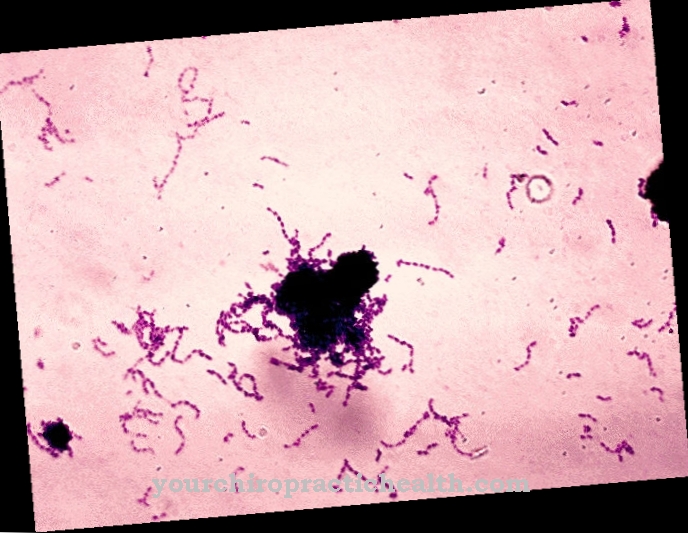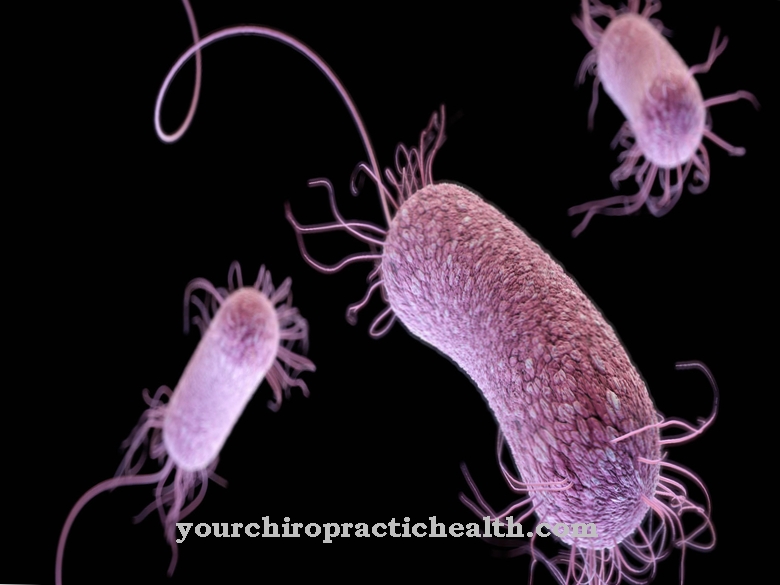The type of bacteria Propionibacterium acnes belongs to the propionic acid bacteria of the order Actinomycetales and the Actinobacteria division. As commensals, the anaerobes naturally colonize human skin, but in the form of individual strains they can also become pathogens. In this context, for example, they play a role in acnes vulgaris.
What is Propionibacterium acnes?
Propionibacteria or propionic acid bacteria have a gram-positive staining behavior and belong to the Actinomycetales order of the Actinobacteria division. They form propionic acid as a metabolic end product on the methylmalonyl-CoA metabolic pathway.
One species of bacteria of the genus Propionibacteria is Propionibacterium acnes, of which about 100 different strains exist. The type of bacteria is anaerobic bacteria that earlier than Bacillus acnes or Corynebacterium acnes were known. Their shape corresponds to a short-growing rod shape. Ellipsoid cell shapes also occur. Individual cells have a width of up to 0.5 micrometers and a length of up to 0.9 micrometers. The cells are usually angled in pairs. As the cells divide, they form V- and Y-shaped cell chains.
The bacterial species does not have flagella for active locomotion. The species forms neither end spores nor other forms of persistence. Most of the 100 tribes of the species are to be understood as commensals that neither benefit nor harm humans. Some strains are suspected of being pathogenic. Research is not yet complete for all tribes.
Occurrence, Distribution & Properties
Propionibacterium acnes forms round colonies after about four days in solid nutrient media with an anaerobic environment, which when viewed from the side appear raised and also appear smooth or shiny. The diameter is up to four millimeters.
As anaerobic bacteria, they are oxygen-tolerant, but do not necessarily need oxygen for their metabolism, but rather are inhibited in growth by O2. The bacteria have the enzyme catalase and form cytochromes. 37 degrees Celsius corresponds to the optimal cultivation temperature, so that the colonization of humans is favorable for their growth. The ideal pH value in the nutrient medium is neutral. Growth is rather slow even under ideal conditions.
Propionibacteria acnes operate chemoorganotroph heterotrophic metabolism. On this metabolic path, organic compounds become energy sources and are used to build up the cells' own substances. A main product of its fermentation is propionic acid, so the fermentation activity is sometimes referred to as propionic acid fermentation. Acetic acid and carbon dioxide are produced as by-products. Carbohydrates such as glucose, fructose or mannose and galactose are usually used as substrates.
In addition to catalase, the bacteria have proteolytic enzymes to break down gelatine and, via nitrate reductase, to liquefy the nitrate. Some strains hemolysis in the blood. The bacteria of the species preferentially colonize the sebum of the hair follicle and are sometimes also found in the digestive tract of humans.
Meaning & function
Up to 100,000 Propionibacteria acnes are present on one square centimeter of human skin without causing disease. In this context, Propionibacterium acnes is primarily considered to be commensal and thus naturally colonizes the human skin flora without being of any benefit or harm. Commensals do not harm their host in their own interests and thus create a longer-term living space.
Of the at least 100 different strains of the species Propionibacterium acnes, most of the strains are considered commensals, but some strains apparently have a certain pathogenicity. Pathogenic bacteria damage their host and lead to disease. The Biological Agents Ordinance and TRBA assign Propionibacterium acnes to risk group 2 because of its, albeit small, number of pathogenic strains. According to the ordinance, microorganisms in this group are “biological substances that can cause disease in humans”.
On the human skin, the bacterium can therefore correspond to a harmless inhabitant, but also to a pathogen. The spread of bacteria into the blood can have even more pathogenic consequences, especially for immunodeficient patients. The conditions under which the individual strains are pathogenic on the skin and under which conditions they correspond to commensals on the skin have not yet been conclusively clarified.
Illnesses & ailments
As a pathogen, the type of bacteria is primarily associated with acne vulgaris and is considered a secondary development factor. As a result, strains of the bacterial species can be detected on healthy human skin without causing acne vulgaris. On the other hand, there is often increased bacterial colonization with Propionibacterium acnes on the skin of patients with acne vulgaris.
The pathogenic strains of the species are said to stimulate cytokine and chemokine production on the cells of the sebum glands. These substances promote inflammatory processes in acne vulgaris. Acne is the most common skin disease in the world. Acne-related inflammation can be accompanied by redness, swelling and itching. Frequently, scars remain.
Propionibacterium acnes multiplies in the comedones under largely anaerobic conditions and uses the enzyme lipase to break down components of the sebum to generate energy. This creates inflammation-promoting substances which, by means of chemotaxis, lure leukocytes into the tissue, which, after they die, create pus-filled pustules.
In addition to acne, diseases such as keratitis and sarcoidosis are now associated with Propionibacterium acnes. Cases of spondylodiscitis, infections of the central nervous system, cardiac infections, osteomyelitis and endophthalmitis or joint infections have already been documented in connection with Propionibacterium acnes.
In addition, circulating immune complexes against Propionibacterium acnes antigens are associated with the SAPHO syndrome from the rheumatic group. The accumulation of immune complexes on bones and joints is said to possibly trigger immune reactions in the context of the SAPHO syndrome, which could explain the rheumatic symptoms.
























.jpg)



